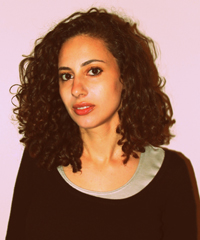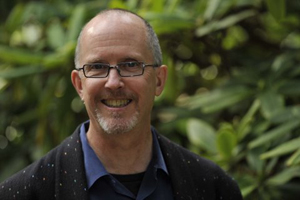A Bicultural Love of the Written Word: John Barton in Conversation with
Thoraya El-Rayyes

Thoraya El-Rayyes, a Palestinian-Canadian translator, lives in Amman, Jordan. Her translation from Arabic of Hisham Bustani’s “Mirror, Mirror” appears in At Home in Translation: Canadians Translate the World, The Malahat Review’s Autumn 2014 theme issue on literary translation in Canada. The story is drawn from The Perception of Meaning, a larger collection of Bustani’s work that El Rayyes has translated into English. In manuscript, it recently won the University of Arkansas Arabic Translation Award and will be published by Syracuse University Press.
I am delighted to have had the opportunity to publish your translation of Hisham Bustani’s “Mirror, Mirror” in “At Home in Translation.” Can you provide a thumbnail sketch of Hisham Bustani’s career, his writing, and his place in Jordanian literary community?
I wouldn’t say there is a Jordanian literary community as such. Partly because Jordan is a very small country (with a smaller population than New Jersey!), but also because—to a great extent—the Arabic literary community transcends national borders. Writers in Arab countries not only share the same language but also have a shared history. Hundreds of years under the rule of the Ottoman and European empires left behind many common traces in these countries, and there have been various pan-nationalist and religious movements that have connected people across the region.
Hisham has published four collections of short fiction, all of which share a rather dark and pessimistic outlook on the human condition. He part of a new generation of experimentalist short story writers in the Arab world that includes writers such as Isma’il Ghazali and Anis Rafa’i from Morocco, Lu’ay Hamzeh ‘Abbas from Iraq, and Muhammad Abu Al-Dahab from Egypt. They are the second generation of modernist short story writers writing in Arabic, building on the work of the previous generation in very interesting ways.
In the case of Hisham’s work, for example, modern technology has had a strong influence on his writing techniques. Some of his stories contain a strong element of cinematography in the sense that a video camera literally zooms in and out on the characters and scenes, and the dialogue in quite a few of his stories integrates SMS and Facebook messaging.
I understand there is a tradition of flash fiction written in Arabic, of which “Mirror, Mirror,” is such a good example. What is it about the form that attracts an author working in Arabic? How would characterize Hisham’s handling of it?
The popularity of flash fiction is more of a recent trend than a tradition. Until recently, poetry had always been the preeminent literary form in Arabic, and the novel in particular is a relatively new addition to the Arabic literary canon. Perhaps the appeal of flash fiction in Arabic is related to this poetic tradition, because I think good flash fiction is similar to poetry in many ways. Both are intense literary forms that bring imagery and symbolism to the forefront. Hisham’s handling of flash fiction definitely reflects this poetic tendency. Actually, the book that “Mirror, Mirror” is taken from is subtitled Stories at the Boundaries of Poetry.
“Mirror, Mirror” is part of a larger survey of Bustani’s work, The Perception of Meaning. Your translation of this collection has just won the University of Arkansas Arabic Translation Award and it will be published by Syracuse University Press. First of all, congratulations to you and Hisham! Secondly, what can readers expect to find when they sit down to spend time with this book?
Thank you! It was an unexpected win because it is a very unconventional text, and certainly is not everyone’s cup of tea. Personally, I like the strangeness of this work. I like that the reader is taken from the underbelly of Amman, to the Korean countryside, to Bhopal in the space of a few paragraphs. I like the motley cast of characters in the stories: a photocopier, a homeless old woman, a fairy princess, a bull, an oil executive and Mark Zuckerberg—to name just a few. It is a kind of collage of tiny nightmares from today’s world: deeply pessimistic, sometimes unsettling, and in some places even funny.
What drew you to translating Arabic? Do you translate any other languages? Do you see your work as a vocation rather than as a profession through which you earn your living, or is it a little bit of both?
I think I became a translator of Arabic almost by default, because I am lucky enough to be a native speaker of both English and Arabic. As a teenager, I used to watch American movies on Jordanian television and I was very preoccupied with the Arabic subtitling. Much to the annoyance of anyone watching with me, I would start a running commentary of all the mistakes in the subtitling:
“They should have used this word.”
“They should have used that word.”
“Look, look what they wrote. How ridiculous!”
“Where do they find these idiot translators?”
and so on…
As well as being bilingual, I’ve spent half my life in Anglophone countries and the other half in Arabic speaking countries so I would also describe myself as being somehow “bicultural.” Having a native understanding of the cultural connotations of literary works in both languages is a privilege that many literary translators don’t have. I think this experience of being a bilingual and “bicultural” lover of literature drove me to translation. There is a lot of scientific research about how bilingual people feel they have a different personality when they speak or write in each of their fluent languages, which makes me think that maybe this imperative to translate comes from a psychological need to create a link between the English-speaking and Arabic-speaking facets of myself.
I am sure books have already been written about this, so briefly, what are the greatest challenges that Arabic imposes on anyone who seeks to translate a literary text into English?
Yes, that is a very big question! I guess the two things I struggle with most are word order and the musicality of the language. The word order in English and Arabic sentences is very different. Arabic sentences tend to begin with action—or in other words a verb—and the reader has to continue reading to know who did what. So for example, a word-for-word translation of “The boy ate an apple” in Arabic reads as “Ate the boy an apple”. I think this structure creates a kind of tension, a kind of suspense in the act of reading the sentence. It can be difficult to translate this feeling into English which has a subject-verb-object sentence structure.
Arabic also flows more smoothly than English does. There are diacritical marks at the end of Arabic words that make nearly every Arabic word end with a vowel sound, so that each word sounds as if it flows into the next, whereas English sounds a lot choppier—more staccato, if you will—with many words that end in consonants. This can make it very hard to retain the musicality of the original Arabic work, which is particularly problematic in translating poetry.
Rereading “Mirror, Mirror,” it struck me yet again how in seven artful pages, at turns lyrical, polemical, erotic, and farcical, Hisham has revised my sense of what would to be a flâneur—to use Baudelaire’s word—in a modern Middle Eastern city. In a very general sense, what do you think a typical English-speaking reader whose only exposure to Arabic literature may have been translations of One Thousand and One Arabian Nights (or worse, the Disney versions thereof) can learn from reading contemporary works like this one? What other writers would you recommend to Malahat readers?
Some of the fantastic contemporary works that are available in English translation include Sonallah Ibrahim’s The Committee and the short stories of Ahmad Faqih. I haven’t read either in translation, so I hope the translations do justice to the original works.
Sadly, people’s interest in Arabic literature in the English-speaking world is very influenced by Orientalist stereotypes: ideas about harems and mysterious veiled women à la One Thousand and One Nights. Or alternatively, people are motivated to read Arabic literature by a kind of voyeurism related to the violent political situation in the region. So even when contemporary Arabic literature is published in translation, the works selected often fall into one of two very narrow categories: stories of oppressed Arab women (with the obligatory sexy-kohl-rimmed-eyes-behind-a-veil cover) or stories whose appeal is to uncover to the Western reader the reasons why “Arabs are so violent”. These works are popular because they feed into a narrative that casts Arabs as a barbaric and backwards “Other” and the rise of these literary genres in translation says more about anti-Arab racism in the Western world than it does about the Arab world itself. That is why I think it is important to promote Arabic literature that does not fit into these categories.
* * * * * * * *










